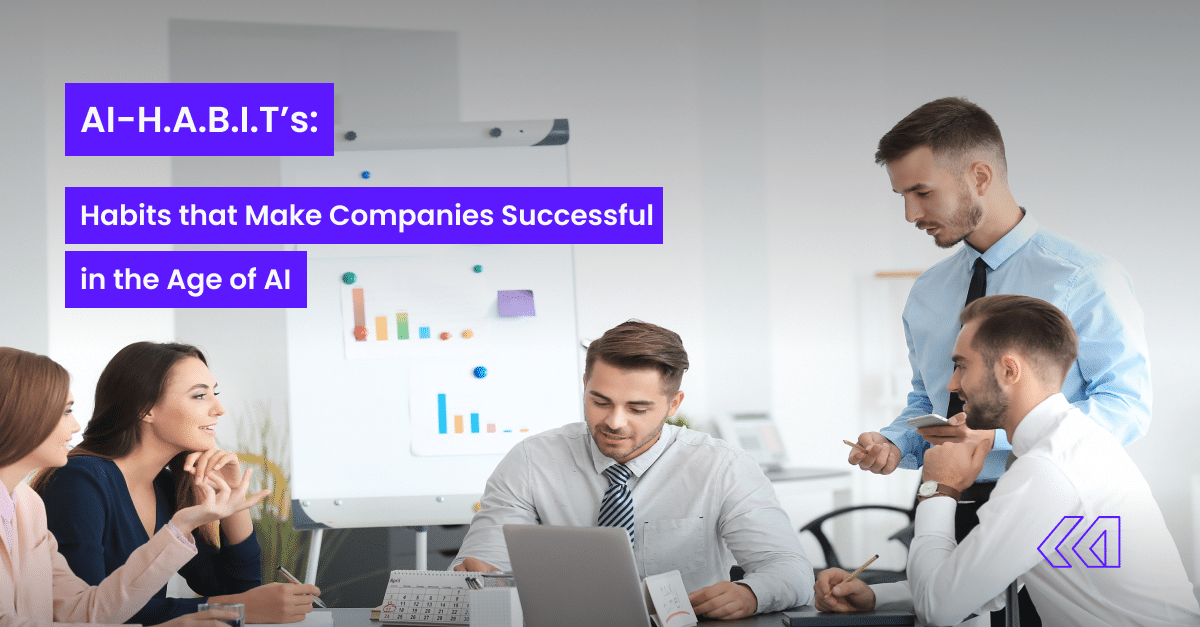AI-H.A.B.I.T.’s: Habits that Make Companies Successful in the AI Era
Artificial intelligence (AI) has undergone an unprecedented evolution in recent years and has become an indispensable tool for businesses. However, it’s not enough to simply use AI; companies must develop systematic habits that transform their processes sustainably and prepare them for the future.
This is where the acronym AI-H.A.B.I.T.’s comes into play – a set of principles that support the successful integration of AI into business operations.
In this blog series, we will take a closer look at these principles and show how companies can gain long-term competitive advantages by embracing these habits.
- 18. March. 2025

Patrick Ratheiser
Founder

H = Healthy: A Healthy Organization through AI Support
The first principle stands for “Healthy” and emphasizes the necessity for a company to be healthy in order to succeed. In the context of artificial intelligence, this means that processes which do not create direct added value should be automated or supported by AI. Routine tasks, especially those that are mentally or manually demanding and tie up resources, can be handled more efficiently with AI.
A healthy organization enables its employees to focus on strategically important tasks that directly contribute to value creation. By automating repetitive tasks with AI, not only are resources freed up, but error rates are reduced and productivity increases. This allows the company to concentrate on its core competencies while maintaining high employee satisfaction by reducing monotonous activities.
A = Analyze: Data as the Foundation for Successful AI Projects
No AI project can succeed without a thorough analysis of the data base. The second principle, “Analyze,” highlights the importance of data analysis before launching any AI initiative. Data is the fuel that powers AI systems – and without high-quality data, every AI project is destined to fail.
Before companies invest in AI, they must analyze their existing data and ensure that it is sufficient in both quality and quantity to train the desired AI model. This also includes reviewing the planned use cases and evaluating whether AI deployment truly makes sense in the given context. A cost-benefit analysis can help estimate the return on investment (ROI) and minimize the risk of poor investment decisions.
The key question is: Does using AI in this specific context create real value — or is it a solution in search of a problem?
B = Build: Developing and Implementing AI Solutions
Building AI solutions is a key step on the path to digital transformation. The “Build” principle describes the various ways AI can be implemented within a company.
There are many different approaches — ranging from simple upgrades of existing systems to the development of customized AI models or the use of Software-as-a-Service (SaaS) solutions.
A crucial element in this process is the adoption of agile working methods. Through iterative development cycles, companies can respond flexibly to new insights and minimize the risk of misaligned solutions. The continuous learning process of AI models, which differs from traditional software development, presents an additional challenge: AI systems must not only be updated regularly, but continuously improved to meet evolving requirements.
This calls for close collaboration between developers, data scientists, and domain experts to ensure that AI solutions are implemented in a practical and effective manner.
I = Inspire: Bringing Stakeholders Along on the AI Journey
Successfully introducing AI in a company requires more than just technical expertise. The “Inspire” principle emphasizes the importance of bringing all stakeholders — both customers and employees — along on the AI journey.
The acceptance of AI solutions largely depends on how well the people affected are informed and inspired.
A key building block in this context is AI literacy, meaning the education of both employees and customers regarding artificial intelligence.
The goal isn’t for everyone to become an AI expert, but rather to develop a basic understanding of how AI works and what it can do. What is AI? What ethical aspects need to be considered? How is AI introduced in a company, and which use cases make sense?
Through targeted training and transparent communication, fears can be alleviated and motivation increased — enabling people to actively contribute to AI projects.
Innovation rarely emerges in isolation; it is much more often the result of teamwork and the exchange of knowledge and experience.
T = Together: Collaboration as the Key to Success
The final principle, “Together,” emphasizes the importance of collaboration and cooperation in the AI space.
Innovation rarely happens in isolation; it is more often the result of teamwork and the exchange of knowledge and experience.
For companies, this means that close collaboration shouldn’t just happen within departments, but also across the entire organization. Involving external experts and exchanging ideas with partners and customers can be critical in gaining new perspectives and developing innovative solutions.
Collaboration is key to unlocking the full potential of AI and developing tailored solutions that meet the specific needs and challenges of the business.
Conclusion: AI-H.A.B.I.T.’s as a Guide for Successful AI Adoption
In summary, the AI-H.A.B.I.T.’s provide companies with a comprehensive framework for successfully implementing artificial intelligence.
By following these habits, businesses can optimize their processes, reduce costs, improve the quality of their products and services, and gain long-term competitive advantages.
However, implementing these principles requires discipline and perseverance.
As with all habits, consistent practice and learning from mistakes is key. Companies must remain flexible, adapt to change, and continuously refine their strategies.
Success in the AI era does not depend on technology alone — it depends on the ability to integrate it meaningfully into the organization and to bring people along on the journey.
Those who prepare for the future in this way won’t just survive — they’ll thrive.
Keep Going.
Have you heard our KI>Inside Podcast yet?
The podcast not only offers fascinating insights into the mechanisms and potential of AI, but also explores what it truly takes to make an AI project successful.